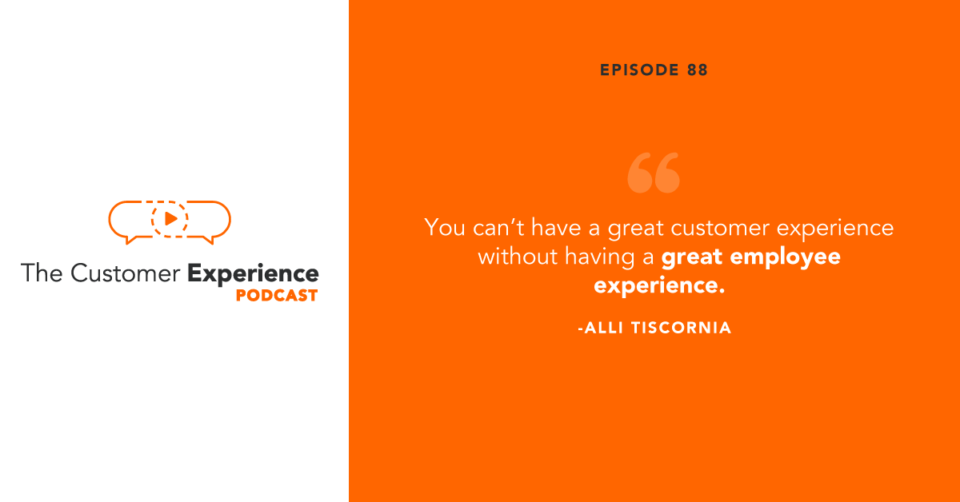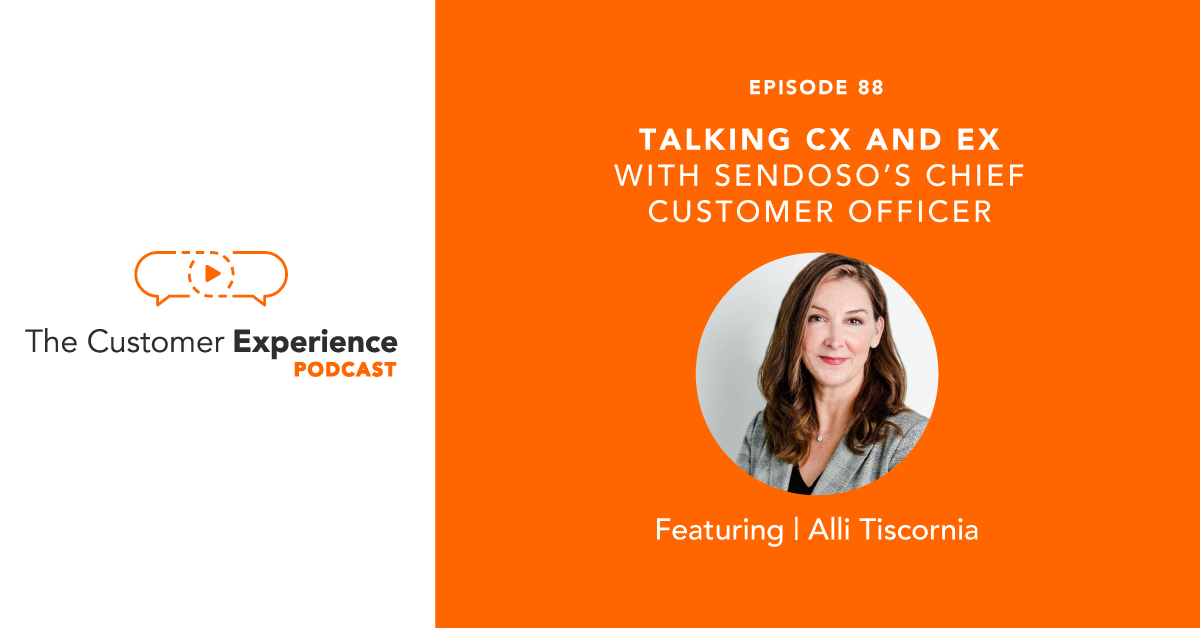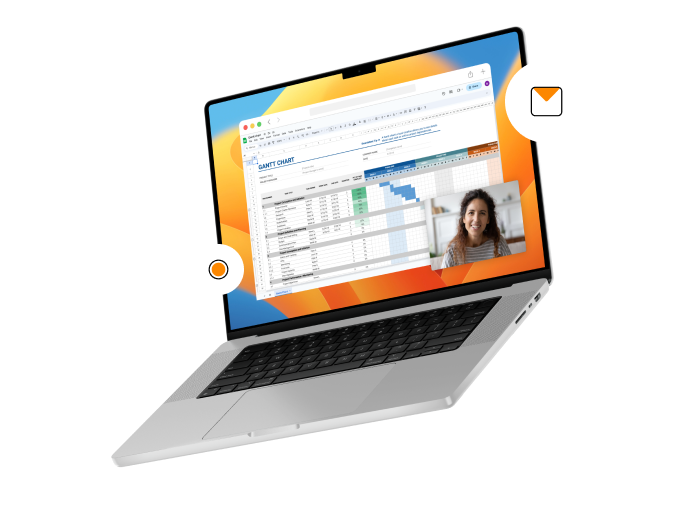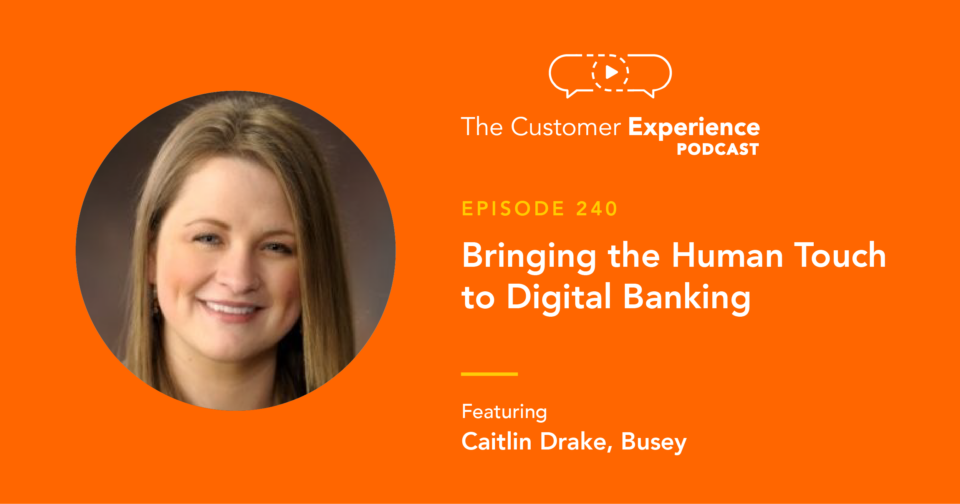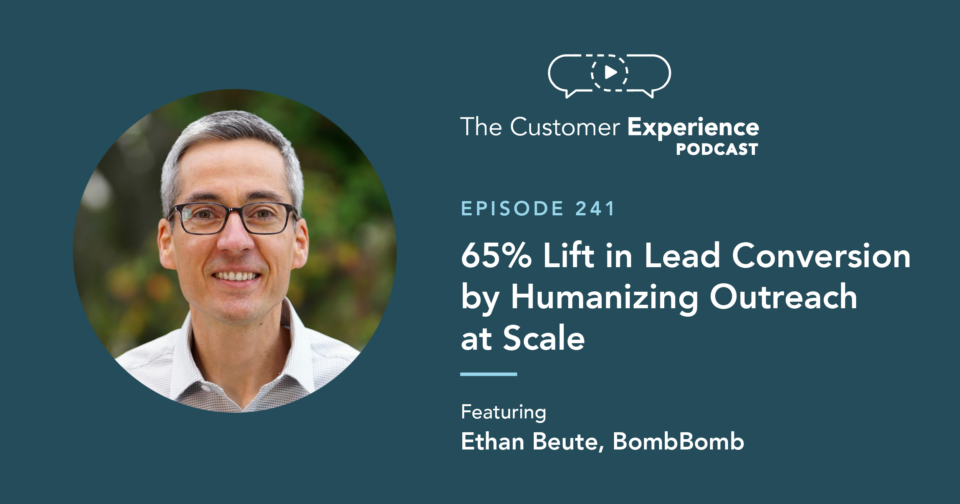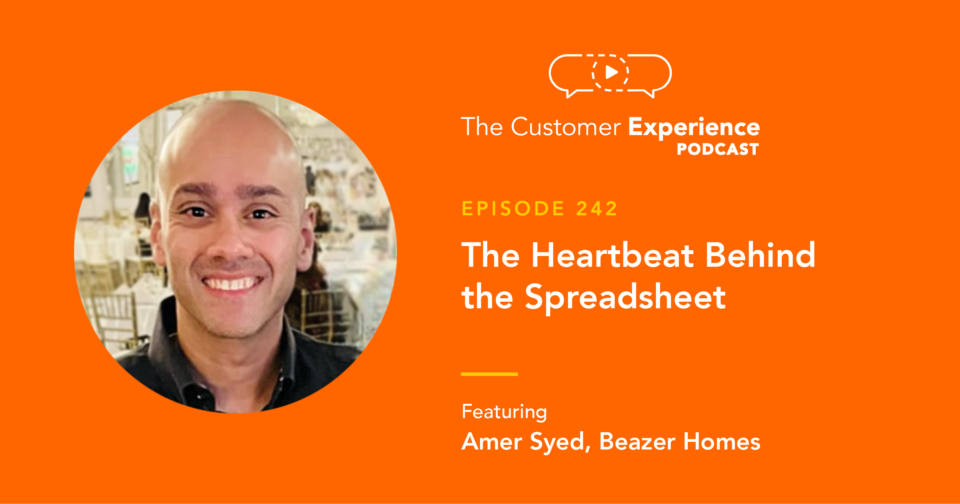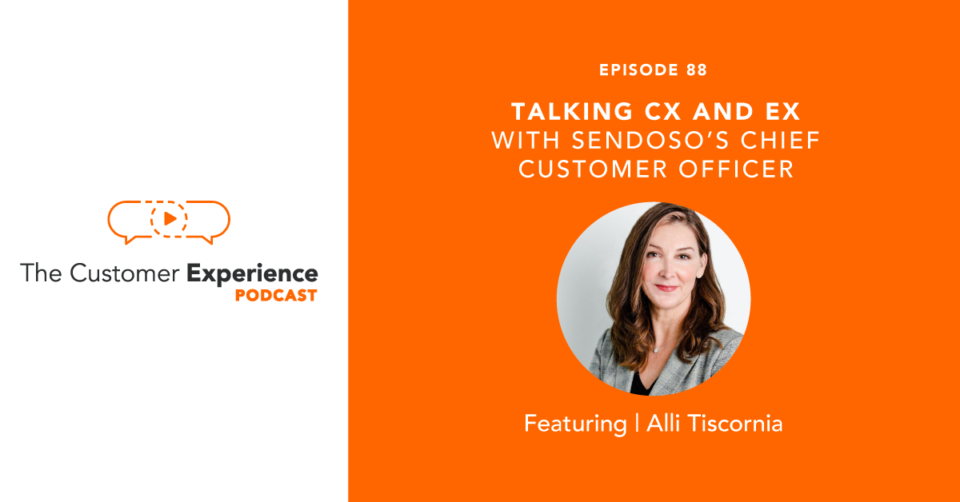
Apple Podcasts | Google Podcasts | Stitcher | Spotify
What is a Chief Customer Officer, exactly? Some report into marketing, some into sales, some into customer success – but there isn’t a lot of unity in how we view their roles. Plus, there aren’t all that many out there in the first place.
CCOs do have this in common: They are “relentlessly focused on the customer experience.”
The guest on today’s episode of The Customer Experience Podcast, Alli Tiscornia, views her role as delivering value to customers in every interaction and at every touchpoint. She discusses several keys to successful value delivery, including making retention the new acquisition, showcasing the customer, and becoming the customer’s true partner.
Alli, Chief Customer Officer at Sendoso, has over 20 years of experience in project management, customer operations, and creating a delightful customer experience that showcases customer stories.
Focused on empathy and relationships, Alli excels in furthering Sendoso’s goals to increase conversion, retention, and ROI by establishing human connections in a digital world.
In this episode of The Customer Experience Podcast, Alli and I discuss…
• What the role of Chief Customer Officer entails
• How to retain and expand your customer base
• How to be a partner, not a provider, to your customers
• Why it’s important to let customers tell their own stories
• Why a great employee experience is essential to a great customer experience
Talking CX and EX with Sendoso’s Chief Customer Officer
Hear the entire conversation with Alli Tiscornia right here:
Hear this episode of The Customer Experience Podcast – and many others – by subscribing to in:
After you click through, please subscribe – and add a rating or review. That one minute of your time is extremely helpful to the show.
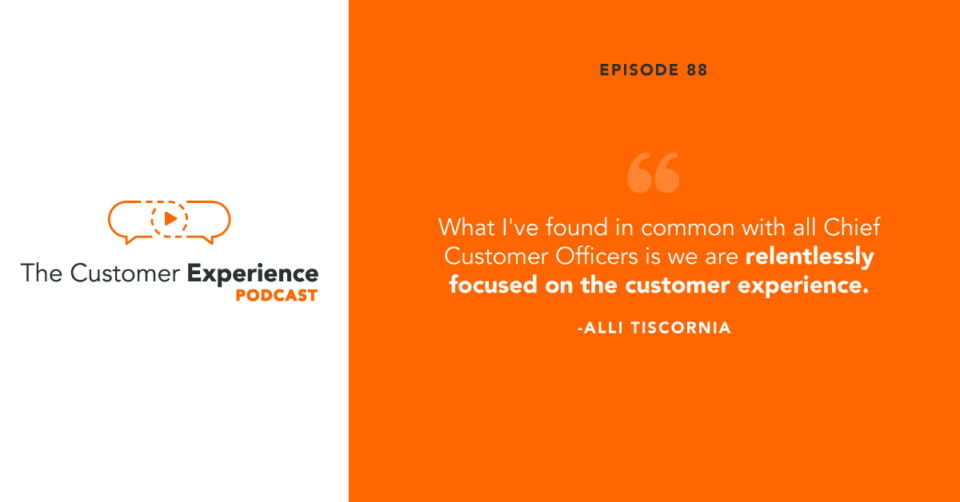
Full Transcript: Talking CX and EX with Sendoso’s Chief Customer Officer
Ethan Beute:
Retention and expansion as your new growth channel, strategic partner rather than service provider as your new approach, customers and employees as your new marketers, we’re talking all that and more today, all through the lens of customer experience of course.
Ethan Beute:
To this conversation, our guest brings more than 20 years of experience in professional services design and delivery, project management, customer operations, and more, with organizations like Zenefits, Medallia, Visa, and Oracle’s Endeca. She currently serves as chief customer officer for Sendoso, the leading sending platform providing a fully integrated way to send personalized items to increase conversion, retention, and ROI. Sendoso’s mission, which I identify with, is to establish human connections in a digital world.
Ethan Beute:
Alli Tiscornia, welcome to The Customer Experience Podcast.
Alli Tiscornia:
Thank you, Ethan. Thank you very much for having me. I’m excited to be here with you today.
Ethan Beute:
Good. Yeah, me too. I would have to double-check but I think you’re the first chief customer officer on the show. So we will get into that, but we’re recording here in late May 2020, you’re in Phoenix, what’s the situation there with regard to the pandemic? How’s it affecting you or your family or your customers or your team? Set the scene for us there really quickly.
Alli Tiscornia:
Like most of the country, we’ve been in some sort of lockdown for the past, I think, eight weeks. Just last weekend, our governor started to open up the state. So I think it’s been a very trying experience. I have two small children at home, so I’m trying to be both the chief customer officer and chief housekeeper, chief educator, chief everything right now at the house, as well as trying to help my team adjust to this new world of work that we’re dealing with as well.
Alli Tiscornia:
I think one of the things that has been pretty interesting to me is the way a lot of companies are coming together with their organizations and how my team in particular has really come together, has really bonded in this time, and has become probably even more productive than we ever thought they could be. It’s amazing when in times of crisis how people pull together. So proud of the people in my team and also proud of the people in Arizona, how they’re pulling together.
Ethan Beute:
I’m really happy to hear that. Everyone always finds silver linings in it, but I feel like you were there the whole time, assuming that you’re embracing the role of chief educator. How old are your kids if you don’t mind my asking?
Alli Tiscornia:
No. I have two sons, 10 and seven.
Ethan Beute:
Yeah. I have a teenage boy, 16. So when he came home from school, he just kind of takes care of himself. He has his laptop, he has all the online assignments. He just comes to with questions. I didn’t have to do anything. I have many team members with kids, multiple kids under the age of 10, and there’s just so many more different demands there. So thank you for what you do to help your team and of course your family.
Alli Tiscornia:
Yes. It’s been interesting and I have such an appreciation for teachers, and I think as a country, we need to pull together and have a greater appreciation for what our teachers do for our children, right? Actually, I love teaching, so I’ve had fun with the boys, but I know that it’s definitely a challenge to go from a working parent to also having to help your children learn.
Ethan Beute:
Right. Is your team distributed already?
Alli Tiscornia:
Yes, they are.
Ethan Beute:
Right. So the interesting thing about teachers in particular… and then we’ll get going on customer experience. The interesting thing about teachers, in particular, is that unlike so many of us, all of their work was in person. Like when I have a parent-teacher conference, I have to physically go to the school and have that conference. That almost all of their work is done face-to-face, in person, in class, on campus, whatever, and so they’re in that group. I’m sure there are others, but they’re the first that come to mind in any of these conversations to be so dramatically affected.
Ethan Beute:
So I agree we should all respect them even more than we already do because all of us, if you’re listening to a podcast like this or you’re hosting it or you’re guesting on it, you’ve benefited from some great teachers in your life or else you wouldn’t be here. So let’s get started in earnest, Alli. When I say customer experience, what does that mean to you?
Alli Tiscornia:
Customer experience to me is really how people engage with your brand, your product, or your service. To me, that is the essence of what customer experience is.
Ethan Beute:
I agree. There’re so many touchpoints there, and some of them are human, some of them are analog, some are digital, some are virtual, some are passive, some are active, and it all adds up really good. For people who aren’t familiar, tell us a little bit about Sendoso. Who is your ideal customer and what do you solve for them?
Alli Tiscornia:
Sendoso is a sending platform. What we do is we help organizations drive revenue, bookings, meetings, retention, by creating these moments of physical impression, which is really trying to break through all of this digital noise and creating this human connection with people by sending them something, right? So Sendoso helps companies have this moment where if you are asking somebody, like a prospect to engage in a conversation with you, what we can do is we can offer that prospect the ability for you to buy them lunch through some sort of e-gift, or we can send something to them that they get to open at their desk, or that they can open from their house, now in this new COVID-19 world.
Alli Tiscornia:
It allows for customers and prospects to have that aha moment and say, “Wow, this is just a completely different customer experience.” So our ideal customer is really anyone that has a sales, marketing, or a customer success organization. We are not vertically-specific. We’re vertically agnostic, really. I mean, we can help any sales, marketing, or customer success organization.
Ethan Beute:
I would assume that online activities can trigger offline experiences and taking online relationships, taking them offline into the physical world. I think more of these bridges need to be built just to round the whole experience out. Just as an example, if someone at Sendoso let’s say… or one of Sendoso’s customers was prospecting me, what are a couple of things that I might receive?
Alli Tiscornia:
You could receive something like a plant, a succulent, right? We do things like that. You could receive cupcakes. You could receive a piñata. I think one of my favorites right now is you could receive an e-gift or you could receive an e-gift that allows you to donate to a charity of your choice. That’s been something that’s been really popular with Sendoso customers right now, is being able to give back in this time of crisis. That’s something that a lot of our customers are using to try to open the door to conversations with prospects or with customers who have gone dark.
Ethan Beute:
Such a good idea. I love this idea of not giving a gift straight to the person but giving them the opportunity to push that forward. So good. Again, I think you’re probably the first chief customer officer on the show. So before we go further, can you just kind of speak to the title? What does it mean to you or what does it mean to Sendoso?
Alli Tiscornia:
The chief customer officer, I think, is a really… it’s a new role. It’s so interesting to me because other chief customer officers that I’ve spoken with, some of them report into marketing, some of them report into sales. I personally, for Sendoso, oversee all of the post-sale organizations. To me, I think what I’ve found in common with all chief customer officers is we are relentlessly focused on the customer experience. We want to make sure that our customers are engaged at every point in that journey and they’re having a fantastic experience all the way through.
Alli Tiscornia:
And to me, that’s the crux of my job, is making sure that we take moments to delight our customers but we also make sure that we’re delivering value to them in every engagement we have with them.
Ethan Beute:
Really good, and that tees up, I guess, the first zone I would love for you just to talk about and we can maybe explore through conversation, which is this idea of the new growth isn’t necessarily acquisition and conversion. Obviously, you’re responsible for everything post-sale, so you may have a bias that way. But I don’t think anyone certainly in SaaS would disagree. And so many business models are going subscription-based where this renewal retention, renewal expansion opportunity really is the new growth. So talk about retention and expansion as the new growth and maybe the way customer experience plays into that.
Alli Tiscornia:
Yeah, absolutely. Retention is the new acquisition. I’ve heard a couple of people say that, right? I think the statistic these days is something around the fact that it costs you five times what you would spend in CAC to acquire a customer versus just retain a customer. So to me, it’s really about making sure that your customer is seeing value and value-based conversations around what they’re doing with whatever SaaS platform product you’re providing to them.
Alli Tiscornia:
They need to be not only engaged in that product, but they need to be seeing value from it every single time they’re engaging with it. So that’s what I think of when I think of how retention is the new acquisition and how it’s so critical that every interaction that you have with a customer is driving value.
Ethan Beute:
One comment, one question specific to this value piece. The observation is, I think sometimes we need to remind our customers that they are getting value because it’s easy for the… You’re paying a lot more attention than they are in some cases. They just want to check the list or get the thing or do the thing or whatever. And so, A, do you agree with that observation? Maybe how are you reminding customers of the value you’re providing? Specifically, are you doing account updates and meetings on a quarterly basis or these types of things or triggered emails that let them know that they’ve received or experienced some form of value?
Ethan Beute:
Then the question is, how do you define or measure that on your own side of it? How do you make sure that your organization, Alli, is adding value in these experiences, in these touchpoints with your customers?
Alli Tiscornia:
Yeah. So I think, honestly, it all starts at the beginning, right? So it does start to some degree in the sales process. I think it’s crucial in the sales process to be asking prospects how they’re going to measure success right upfront with your product or your platform. So that’s one of the things that we try to drive at Sendoso, is to make sure that we understand exactly what their goals are in the business and the organization, and then how can we enhance that and add to that and make sure that we can measure ourselves against that.
Alli Tiscornia:
Then what we do is, after that’s transitioned to us from the sales process into our onboarding process, we make sure to go over that once again. Okay, is this why you bought Sendoso? You bought Sendoso because you want to increase your pipeline, you want to drive more pipeline for your SDRs. So how are we going to measure that? Is it a matter of 1X, 2X, 3X what you have today with your pipeline? So that’s our success metric, that’s our success criteria. Then we take that through the entire life cycle of the customer, right?
Alli Tiscornia:
So then once we transition to a customer success manager, we’re making sure that the customer success manager in their first call with the customers is saying to them, “Okay, just want to make sure we talked about at the beginning when you were onboarding that pipeline generation was your biggest priority, that’s how we were going to measure success. This is what it looks like today. We’ve generated 2X what you already had in pipeline.” So you just have to keep coming back to those original success metrics. Also, I think you also have to go back and ask the customer, “Has anything changed? What in your business has changed?”
Alli Tiscornia:
No business is ever static, right? So you have to go back and continue to have the conversation and continue to ask and see where they’re at.
Ethan Beute:
Yeah. I love it. It also makes me think of, you initially wanted to do this, we’ve been doing this, we’ve achieved this, let’s keep doing that, but we can also do this, that, or the other thing for you as well. This goes in already to the new approach theme, which is, more a partner than a service provider. I mean, that’s what it sounds like here because you’re speaking some of the language that I love in this ongoing conversation on the Customer Experience Podcast. One of these little nuggets here is, adapting the customer’s metric or goal as your own and being a partner in solving that.
Ethan Beute:
So speak at a high level to this idea of a mental shift, especially on what would have traditionally been, say five… I don’t know how long. I haven’t been tracking the progress. But culturally, probably five or 10 years ago, it really was at least on your side of the house post-sale really a support customer service type thing, like, “Call us when you need us.” But partner has different connotations. So speak to that shift a little bit and then we can maybe talk about a couple of the details beneath it.
Alli Tiscornia:
So to me, the shift has really been about becoming a customer advisor or a trusted advisor, and becoming a customer-centric organization really is about this idea of, you are the expert in your product or your service or your platform and you need to be able to guide customers on how to leverage that product, service or platform in the best way that they can for their business. I think it’s really very consultative. It’s about how the customer has a problem and how you can go about solving that problem for them and showing them different ideas.
Alli Tiscornia:
Especially for us in Sendoso, it’s really about understanding what they’re trying to achieve and the different sending ideas that we have for those different problems. To me, that’s what really a trusted advisor becomes, is they’re a partner with you. They’re trying to help you solve a business problem to make you as the customer as successful as possible. I think that is very, very different than the world in which we used to live, and certainly the world in which I experienced where it was just about being reactive.
Alli Tiscornia:
It was just about, “Oh, you’ve got a problem and so let me see. It’s a technical problem. I’ll try to fix it in the platform for you,” versus really trying to understand your customer’s business and how you can make them shine.
Ethan Beute:
Yeah. I love the proactivity there. I think that’s fundamental to this shift in perspective or approaches. This proactivity is, “Okay, what more can I do or how can I help solve this problem or achieve this goal or achieve this metric with them and for them.” Couple assumptions here and I’d love for you to speak specifically about what you’re doing within your team around this. I would assume that there are playbooks for some of these primary outcomes.
Ethan Beute:
So talk maybe about how you build or maintain or develop those or train into those as you may bring on new CSMs or these types of things. This is related. How do you document new and interesting learnings so that as different people are engaging with these different customers… Again, your vertical agnostic, so you’re serving all these different types of people. I would imagine that there are really cool stories and outcomes happening across all these different accounts. So how do you loop that back into your CS organization, but perhaps even into sales and marketing?
Alli Tiscornia:
So I love the fact that you brought up success stories because this is where I get really excited. To me, customer success is all about figuring out where those success stories are, right? What I do with our team is I basically go in and I ask them to come back with how many… Is it three customer success stories per quarter? I want to know who is sending the most, what their use case is, what the ROI is on that use case, and then I want to see exactly what the results have been from the customer and then whether or not the customer is willing to talk about it, right?
Alli Tiscornia:
And how can we showcase our customer and how can we actually put them in a position to showcase their business or showcase what they’re doing? One of the things that we’ve actually done at Sendoso, we started to have customers come and talk at our all-hands, and talk about not only their product or their service, but also to talk about how they’ve been successful with our product and how they’ve been leveraging it. So that’s how we capture the success of our customers and then filter that out into the organization. Then we work with marketing obviously to make sure that we capture these customer success stories so that sales can leverage them, that the CSR can leverage them.
Alli Tiscornia:
Sometimes even support can help us with that too and reference those success stories. But to me, it’s really about, as a customer success team, being really good listeners and letting your customer tell their story because I think as humans, we get excited about showcasing our successes. Most customers I know love to tell us where they’ve seen success, where they’ve been happy with our product. They get so excited to tell us their story.
Ethan Beute:
I love this idea of bringing customers that close into the organization. Another one of my guests on the podcast has actually been on twice, Sangram Vajre at Terminus. They bring them into the… Of course, you can’t do that anymore right now, but also it was the first time I heard about bringing customers into the office and doing this direct connection, which is such a privilege. We experience a little bit of it at BombBomb because we do so much video communication in and out of the organization. Our customers, of course, are sending videos back.
Ethan Beute:
But this relationship orientation, I think probably… and I’d be curious to know your experience or observations on this, and then we can move on. Your team is very customer-facing, sales is very customer-facing, marketing a little bit, product and dev not as much. So I would guess that this value of bringing customers in to tell their story, to share who they are, to share how they’re using the platform, is probably especially informative to the less customer-facing folks on the team.
Alli Tiscornia:
Oh, absolutely. One of the most popular part of the all-hands that we have is when we have customers coming to tell their stories. Everybody in the company gets excited about it. Everybody loves it. But it’s really interesting that you bring up product and end, right? I mean, they are extremely excited. Especially for us at Sendoso, we do have an offshore engineering team. They get very excited to hear about our customers and to see where our customers are doing well with our product and platform.
Alli Tiscornia:
It’s interesting because, again, everybody gets so happy and so excited when a customer comes and talks to us. We’ve been really successful having customers talk to us on Zoom. I mean, there’s still that level of excitement when a customer pops into the Zoom and you’re like, “Oh my gosh! Tell us about what you’ve done with a send from Sendoso.”
Ethan Beute:
Yeah. All of us wants to know that our work matters. We’re actually talking about that a little bit before we hit record. All of us just want to know that our work matters and there’s no better way to… It’s nice to see it up on the scoreboard; retentions, we beat expectations by 23 points or whatever, and you can see it in the metrics. But it’s a whole different thing to meet another human and to know that the work that you did impacted their life and their career and their business and their success. So satisfying.
Ethan Beute:
Let’s shift to the third and final topic here, which is the new marketers. This is something I believe as well that your customers are your best source of new customers and that your employees are also a great source of new employees and potentially new customers, that a great customer experience is a natural outcome of a great employee experience. So talk about some of these cross benefits of building relationships, having empathy, treating people well, I guess all these natural foundational pieces to creating a great employee experience and the employees and creating a great customer experience.
Ethan Beute:
How does that dynamic go for you either within Sendoso or anywhere really in your career observations you picked up along the way?
Alli Tiscornia:
To me, I don’t think you can have great customer experience without having a great employee experience. So if your employees aren’t happy, they aren’t going to be able to take care of your customers. It will naturally show through, right?
Alli Tiscornia:
So to me, it starts with making sure that your employees are truly engaged and they’re happy. I think a lot of times people think, well, that just equates to additional pay or additional monetary incentives. I think there’s a lot of research out there that, yes, those things are important, but the other thing that’s really, really important to an employee experience and employee engagement is feeling like they can make a difference, feeling like they have the power to make a difference to their customer.
Alli Tiscornia:
That’s one of the things that actually brought me to Sendoso, because having run a support organization, having run implementation teams, I know, and especially with support organizations, people don’t necessarily call support organizations because they’re having a great day or they’re having a great experience with your product and they want to just tell you how happy they are with your product, right? They’re calling support because something is broken, something that is not going really well.
Alli Tiscornia:
I always say that I think support is one of the hardest jobs to have at a company because you’re on the phone or you’re chatting with people all day long who aren’t particularly excited, right? They’re not particularly happy. And if there’s a way that you can use those employees the ability to make a difference to that customer that they have on the phone right there or they’re chatting with it, it makes the customer’s day, it also makes the employee’s day. The employee just gets very excited about that.
Alli Tiscornia:
And this is actually what brought me to Sendoso because I feel like there’s a real need for frontline staff to feel empowered to make a difference in the life of their customer in that moment that they have that interaction with them.
Ethan Beute:
Was there anything on your way in that you immediately wanted to implement or do? Was there any big change or a philosophical approach that you wanted to build into the team right away? What were some of your first approaches on the employee side in particular?
Alli Tiscornia:
To me, coming into Sendoso, I really tend to be a very collaborative leader. So for me, it was really about building a cohesive, collaborative team and making sure that there weren’t any silos between organizations, right? There’s a tendency sometimes between the sales team and the post-sale team to have that natural kind of friction. So it was really important for me to make sure that all of those barriers are knocked down and to make sure that everybody understands that we’re one team, we’re one organization and our entire drive is about the customer and making sure that the customer has the best experience possible.
Alli Tiscornia:
Then the other thing for me coming into Sendoso is I’m a big proponent of, we have to drink our own champagne, right? So I want to make sure that when our customers engage with us, that they’re having the best experience, and that when things do go wrong because things tend to go wrong sometimes with software and SaaS and platforms, that we can use Sendoso to actually get through that experience with the customer. So if there’s a time when maybe we’ve made a mistake that we go ahead and do something and send something to our customer as an apology and just stick with us and bear with us.
Ethan Beute:
So good. I think you have an advantage that we have as well at BombBomb, which is that you can use your product to demonstrate its value. In your case, it’s like a make good or a, “Hey, thanks for sticking with us.” Or on the sales side, I’m sure it’s a, “Hey, did you enjoy that experience? You can create the same thing for your prospects as well.” So it’s a really nice advantage to have just one more pass here and it’s a little bit operational. So you’re chief customer officer, you’re responsible for everything post-sale.
Ethan Beute:
So I would assume that you maybe have like a head of support and a head of CS proper maybe that’s running account managers or CSMs. Just talk about your organization. How big is it? How is it organized? And perhaps, because I’m sure you were asked the same question when you were interviewing and considering the opportunity for yourself to join, why a chief customer officer here?
Alli Tiscornia:
So we do. We have about 50 people and we have, on my side of the fence, we have our solution architects. We have an onboarding team, we have a customer success team, we have a support organization, and then we also have what we call our sender experience team. I think the reason that we, Sendoso, chose to have a chief customer officer was because Sendoso is a very, very customer-centric organization and our CEO believes in the power of the customer. So he really felt like it was important that these post-sale teams all be organized under one leader and one umbrella that is, again, relentlessly focused on that customer experience.
Alli Tiscornia:
So all of those teams, again, that goes back to this point where I wanted to make sure that those teams, that they were functioning in much more of a siloed way, understood that this is all part of the customer journey, we’re all one, and we’re all one organization.
Ethan Beute:
Yeah. I mean, as soon as you were halfway through the explanation of the various teams within your organization, I was like, “Yeah, I would want a chief customer officer too.” Just to tie it all together really quickly, the sending experience team, all the other names I’m familiar with, what is the sending experience team’s number one goal?
Alli Tiscornia:
Yeah. So this is what’s really exciting to me, because the number one goal of the sender experience is to make sure that those users of our platform are having a really great experience, right? And I find this on a lot of SaaS companies, right? The group that implements the solution or the tool, the users are not necessarily the same people, right? So a lot of times, especially for our product, we’ll have a marketing team that will implement Sendoso, but the actual users of Sendoso could potentially be the sales organization, right?
Alli Tiscornia:
So to me, it’s critical that while our context may have been more in the marketing because those are the people that set up the platform, we need to make sure that those salespeople are getting the most out of Sendoso, are using it, are leveraging it, and are seeing the value from the platform. So that’s why we created the sender experience team to make sure that they are relentlessly focused on the user community because to me, retention of a product or a platform really is how sticky you are with that user base.
Alli Tiscornia:
It’s not just the people who buy you, but it’s the people who are using you on a day-to-day basis, and so we can’t not think about that group. We have to be very engaged with them.
Ethan Beute:
Really good. I’m so glad I asked that question and I could tell how you were excited you were about that aspect. It makes me think about an entirely new conversation topic because we don’t have time for it today. But it’s so interesting that so often, and I know it happens to us as well, and I know our two companies aren’t unique in this, and so we should probably talk it out more. And I’m sure it’s going to turn into a background theme on the show now that it’s top of mind for me and you trimmed it-
Alli Tiscornia:
I’m now going to come back and talk about those topics. I’m really excited about it.
Ethan Beute:
This idea that you’re potentially selling, that you’re engaging, conversing with, selling into, and even implementing with a different stakeholder than is actually going to use it, and it seems so obvious to say it that way, but it happens so often. I love that you built a team around it. So if you’re listening to this episode and you enjoyed it, I’ve got a couple more that I know you’re going to enjoy. Episode 63 with David Meerman Scott who wrote a book called Fanocracy. We called that episode Creating Fans Through Human Connection.
Ethan Beute:
We talked here in this conversation about different ways to engage not only your team members but of course also your customers in the way that Sendoso is doing that online to offline. That’s episode 63 with David Meerman Scott. Also, episode 71 with Ed Breault who’s the CMO at a digital asset management platform called Aprimo. We talked about the customer as the new marketer. That’s one of his mantras for 2020. That episode was called Differentiating Your Brand by Humanizing the Experience. Episode 71 there. Alli, this has been really, really fun. I so glad that we were able to spend this time together.
Ethan Beute:
Before I let you go, I’d like to give you two opportunities to shout a couple people out. One is someone who’s had a positive impact on your life or career and the other is a company or a brand that you really enjoy or appreciate or respect for the experience that they deliver for you as a customer.
Alli Tiscornia:
So I would love to give a shout out to a mentor of mine and somebody who I respect from a leadership perspective, somebody who helped to develop me, I think, as a leader and also who I’ve seen go on to bigger, better, amazing things. That gentleman’s name is Chris Comparato. He is the CEO of Toast. He was my manager back in the day at Endeca. I learned so much from him. I learned not only how to be a manager but how to be an effective manager and how to actually be a human-centric manager.
Ethan Beute:
Awesome. How about a brand or a company that you appreciate?
Alli Tiscornia:
So the brand or company that I will be loyal to for life is a company called Stitch Fix. So Stitch Fix sends out curated boxes of clothing because I happen to really be into fashion. My loyalty to that brand is derived from the fact that about two years ago my father passed away and I was holding a memorial service at my house. And my Stitch Fix package was going to be delivered at exactly the same time that my father’s memorial service was going to start. It kind of dawned on me that, like the day before, that this was going to happen. I didn’t necessarily want my guests showing up at the same time or the service starting at the same time that my Stitch Fix package was going to be coming.
Alli Tiscornia:
So I reached out to Stitch Fix, explained the situation, and just asked them if they could hold the package for me and then that I would go pick it up at the UPS store or something like that. The support organization over there was so fantastic. They said, “Alli, don’t worry about it. You go focus on the thing that’s important to you. Take care of yourself, take care of your family, we’ve got this, we’ll take care of your package. No worries.” About three hours later, flowers showed up for my father’s memorial service and it was from the Stitch Fix support organization.
Ethan Beute:
What a beautiful story. I’m sorry for your loss and I appreciate you sharing that story. It’s so good. That is the third time, this has never happened, that’s the third time Stitch Fix has come up at this point in the conversation. Sarah Toms from the Wharton Interactive Organization at the Wharton School of Business at Penn, and Paula Hayes, who is the CEO and founder of a cosmetics company called Hue Noir, both mentioned Stitch Fix. And you added a new layer to it. I mean, I think both of theirs was this blend of a digital experience but also a human experience.
Ethan Beute:
It feels human, you know that a human is picking stuff out for you, but it’s also partly algorithmic and all of this blend of human and digital. But you added a whole new layer to the human side of it, where they immediately just washed all the problem away and then went another step beyond. It’d be enough just to say, “Hey, don’t worry about it. Focus on what matters most, fellow human being.” I would want the same thing if I was you, but that extra touch is just beautiful. Thank you so much for sharing that.
Alli Tiscornia:
Thank you. It was a pleasure being here and it was wonderful to have that experience with Stitch Fix.
Ethan Beute:
Yeah. If folks want to follow up with you, Alli, or with Sendoso, where are a couple of places you might send them?
Alli Tiscornia:
Yeah. You can reach out to me on LinkedIn. I’m on LinkedIn as Allison Temple Tiscornia. You can reach out to me directly at alli@sendoso.com, and then you can check out Sendoso at our website, sendoso.com.
Ethan Beute:
Awesome. For folks who are listening, I link all of that stuff up. I do short write-ups. We put in video clips. We have the fully embedded audio in addition to of course being in Apple Podcasts, Spotify, Google Podcasts, and all the other places. You can always visit bombbomb.com/podcast to get a little bit closer to the guests through video and to follow up if you’d like to do that as well. So thank you so much for listening and thank you again, Alli, for spending time with me.
Alli Tiscornia:
Thank you, Ethan.
Video Highlights: Talking CX and EX with Sendoso’s Chief Customer Officer
Check out the top five video highlights from the discussion with Alli Tiscornia of Sendoso below…
1. The Role of Chief Customer Officer
2. The New Growth – Retention and Expansion
3. The New Approach – Partner, Not Provider
4. The New Marketer – Your Customer
5. The New Marketer – Your Employee
Similar Episodes Of This Podcast That You’ll Enjoy:
- “Differentiating Your Brand by Humanizing The Experience” with Ed Breault (CMO, Aprimo)
- “Creating Fans Through Human Connection” with David Meerman Scott (Author, “Fanocracy”)
- “Create Delight to Keep Customers for Life” with Jordan Olivero (Director of Customer Success, Swimlane)
Subscribe, Listen, Rate, and Review The Customer Experience Podcast:
